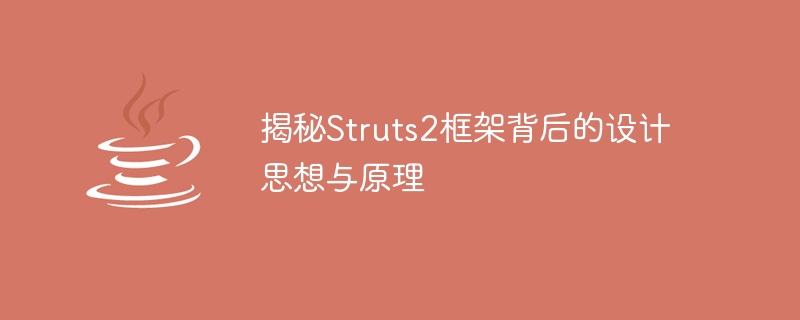Home >Java >javaTutorial >Decipher the design principles and ideas of the Struts2 framework
Decipher the design principles and ideas of the Struts2 framework
- WBOYWBOYWBOYWBOYWBOYWBOYWBOYWBOYWBOYWBOYWBOYWBOYWBOriginal
- 2024-01-05 17:41:42704browse

Revealing the design ideas and principles behind the Struts2 framework
Introduction
With the continuous development of Web applications, developers need to face more and more Complex requirements and technical challenges. In order to better solve these problems, software development frameworks emerged. Struts2 is a Web application development framework based on the MVC (Model-View-Controller) architecture. It uses a series of design ideas and principles to help developers build stable, scalable, and easy-to-maintain applications. This article will reveal the design ideas and principles behind the Struts2 framework and illustrate it through specific code examples.
Core Principle
- MVC Architecture
Struts2 adopts the MVC architecture and divides the application into three main components: Model and View (View) and controller (Controller). The model is responsible for handling business logic and data storage, the view is responsible for displaying data and interacting with users, and the controller is responsible for receiving user requests and selecting appropriate model logic and views to present the data. By separating different parts of the application, developers can better organize and manage code, improving the maintainability and scalability of the application.
- Configuration driver
Struts2 provides a central configuration file (struts.xml) through which various behaviors and processing logic of the application can be defined. Developers can define routing rules, interceptors, result types, etc. through simple configuration. This configuration-driven approach enables developers to implement complex functions through simple configuration, avoiding heavy coding work.
- Request processing process
The request processing process of Struts2 can be divided into the following steps:
(1) The user sends a request to the server.
(2) The server hands the request to the Struts2 framework for processing according to the mapping rules of the URL.
(3) The Struts2 framework selects the appropriate Action to handle the request based on the routing rules in the configuration file.
(4) Action executes the required business logic and returns a result.
(5) According to the configuration of the result type, the Struts2 framework presents the results to the user.
This request processing process allows developers to focus on the implementation of business logic without caring about specific request processing details.
Sample code
The following is a simple Struts2 application example:
- Define an Action class:
public class HelloWorldAction extends ActionSupport {
private String message;
public String execute() {
message = "Hello, World!";
return SUCCESS;
}
public String getMessage() {
return message;
}
// 其他业务逻辑方法...
}- Configure routing rules and result types in the configuration file (struts.xml):
<struts>
<package name="default" namespace="/" extends="struts-default">
<action name="hello" class="com.example.HelloWorldAction">
<result>/hello.jsp</result>
</action>
</package>
</struts>- Create a JSP view file (hello.jsp) for displaying results:
<html>
<head>
<title>Hello, World!</title>
</head>
<body>
<h1>${message}</h1>
</body>
</html>The above code example demonstrates the implementation process of a simple Hello world application. Through the routing rules in the configuration file, the Struts2 framework can select the appropriate Action to process the logic based on user requests and return the results to the user.
Summary
The Struts2 framework adheres to a series of design ideas and principles to enable developers to better build Web applications. Through MVC architecture, configuration driver and flexible request processing process, the Struts2 framework provides a flexible and scalable development model. I hope this article can help readers have a deeper understanding of the design ideas and principles behind the Struts2 framework, and can flexibly apply it in actual development.
The above is the detailed content of Decipher the design principles and ideas of the Struts2 framework. For more information, please follow other related articles on the PHP Chinese website!
Related articles
See more- Analysis of design principles for getting started with html5
- Use css3 to implement the five-pointed star style in the web page (principle analysis)
- Let's talk about python programming ideas
- Analysis of methods and principles of online chat using Workerman
- An in-depth exploration of how the struts framework works and its practical uses

